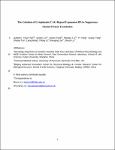Gelation of cytoplasmic expanded CAG RNA repeats suppresses global protein synthesis
| dc.contributor.author | Pan, Y | |
| dc.contributor.author | Lu, J | |
| dc.contributor.author | Feng, X | |
| dc.contributor.author | Lu, S | |
| dc.contributor.author | Yang, Y | |
| dc.contributor.author | Yang, G | |
| dc.contributor.author | Tan, S | |
| dc.contributor.author | Wang, L | |
| dc.contributor.author | Li, P | |
| dc.contributor.author | Luo, S | |
| dc.contributor.author | Lu, B | |
| dc.date.accessioned | 2023-11-02T13:13:37Z | |
| dc.date.available | 2023-11-02T13:13:37Z | |
| dc.date.issued | 2023-11 | |
| dc.identifier.issn | 1552-4450 | |
| dc.identifier.issn | 1552-4469 | |
| dc.identifier.uri | https://pearl.plymouth.ac.uk/handle/10026.1/21551 | |
| dc.description.abstract |
RNA molecules with the expanded CAG repeat (eCAGr) may undergo sol–gel phase transitions, but the functional impact of RNA gelation is completely unknown. Here, we demonstrate that the eCAGr RNA may form cytoplasmic gel-like foci that are rapidly degraded by lysosomes. These RNA foci may significantly reduce the global protein synthesis rate, possibly by sequestering the translation elongation factor eEF2. Disrupting the eCAGr RNA gelation restored the global protein synthesis rate, whereas enhanced gelation exacerbated this phenotype. eEF2 puncta were significantly enhanced in brain slices from a knock-in mouse model and from patients with Huntington’s disease, which is a CAG expansion disorder expressing eCAGr RNA. Finally, neuronal expression of the eCAGr RNA by adeno-associated virus injection caused significant behavioral deficits in mice. Our study demonstrates the existence of RNA gelation inside the cells and reveals its functional impact, providing insights into repeat expansion diseases and functional impacts of RNA phase transition. | |
| dc.format.extent | 1372-1383 | |
| dc.format.medium | Print-Electronic | |
| dc.language | en | |
| dc.publisher | Springer Science and Business Media LLC | |
| dc.subject | Humans | |
| dc.subject | Mice | |
| dc.subject | Animals | |
| dc.subject | Trinucleotide Repeat Expansion | |
| dc.subject | RNA | |
| dc.subject | Protein Biosynthesis | |
| dc.subject | Huntington Disease | |
| dc.subject | Disease Models, Animal | |
| dc.subject | Huntingtin Protein | |
| dc.title | Gelation of cytoplasmic expanded CAG RNA repeats suppresses global protein synthesis | |
| dc.type | journal-article | |
| dc.type | Article | |
| plymouth.author-url | https://www.ncbi.nlm.nih.gov/pubmed/37592155 | |
| plymouth.issue | 11 | |
| plymouth.volume | 19 | |
| plymouth.publisher-url | http://dx.doi.org/10.1038/s41589-023-01384-5 | |
| plymouth.publication-status | Published | |
| plymouth.journal | Nature Chemical Biology | |
| dc.identifier.doi | 10.1038/s41589-023-01384-5 | |
| plymouth.organisational-group | |Plymouth | |
| plymouth.organisational-group | |Plymouth|Research Groups | |
| plymouth.organisational-group | |Plymouth|Faculty of Health | |
| plymouth.organisational-group | |Plymouth|Research Groups|Institute of Translational and Stratified Medicine (ITSMED) | |
| plymouth.organisational-group | |Plymouth|Research Groups|Institute of Translational and Stratified Medicine (ITSMED)|CBR | |
| plymouth.organisational-group | |Plymouth|REF 2021 Researchers by UoA | |
| plymouth.organisational-group | |Plymouth|Users by role | |
| plymouth.organisational-group | |Plymouth|Users by role|Academics | |
| plymouth.organisational-group | |Plymouth|REF 2021 Researchers by UoA|UoA01 Clinical Medicine | |
| plymouth.organisational-group | |Plymouth|Faculty of Health|Peninsula Medical School | |
| plymouth.organisational-group | |Plymouth|Users by role|Researchers in ResearchFish submission | |
| dc.publisher.place | United States | |
| dcterms.dateAccepted | 2023-06-13 | |
| dc.date.updated | 2023-11-02T13:13:07Z | |
| dc.rights.embargodate | 2024-2-16 | |
| dc.identifier.eissn | 1552-4469 | |
| rioxxterms.versionofrecord | 10.1038/s41589-023-01384-5 |


